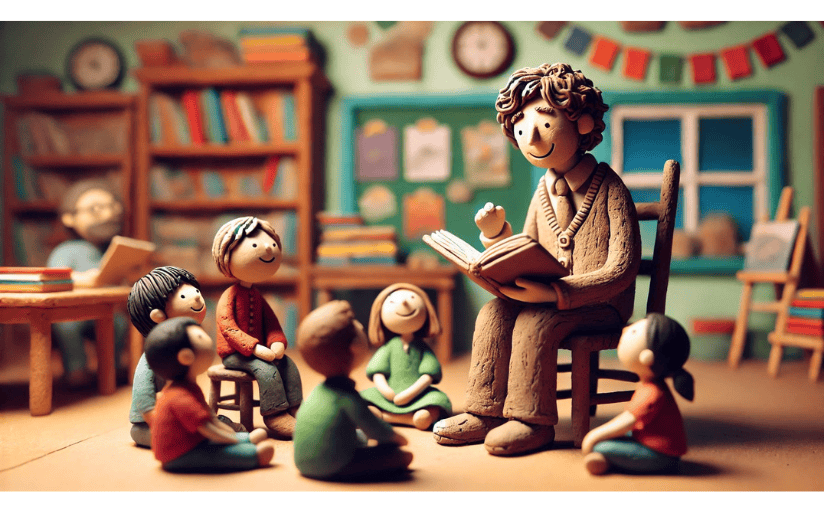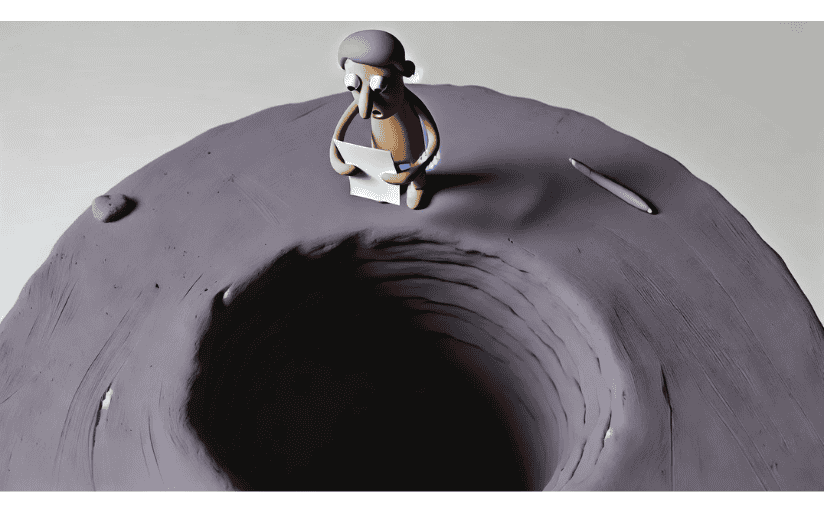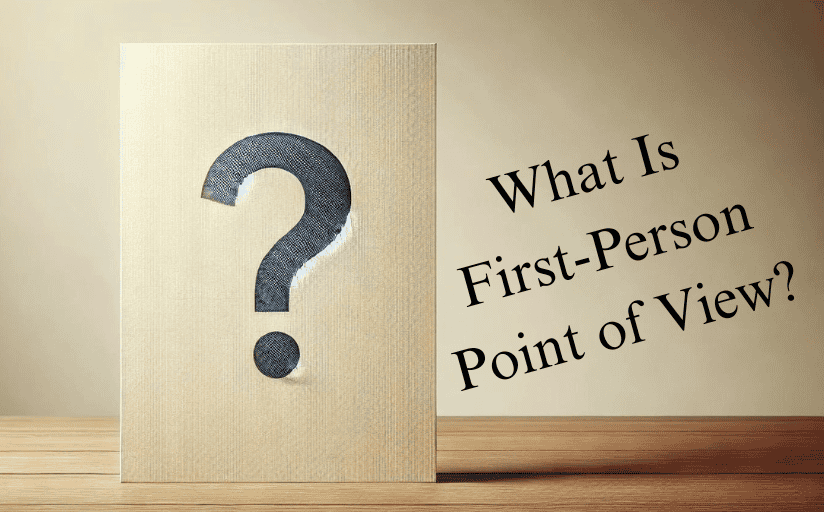What point of view will best serve your piece? You should ask yourself this question before every project, whether it’s a report for work or the beginning of a novel. First-person point of view is a default for many writers, though its use can be controversial depending on the context and may be completely inappropriate in some instances. So, what is first-person point of view, and how should you use it? Here’s the breakdown of this literary term and how its use impacts your writing.

What Does “First Person Point of View” Mean?
“Point of view” describes narrators and their relationship to a piece’s subject. There are three POV types:
- First-person
- Second-person
- Third-person
First- and third-person POV are the most prevalent in fiction, while second-person POV is generally used in more technical or nonfiction writing. The first-person point of view is when narrators directly address their audiences as subjects or observers of the story, as in the following examples:
- Narrator tells the story of a personal experience
- Narrator gives an account of an event he or she witnessed
- Narrator describes his or her plans for an upcoming project
First-person point-of-view words include “I” and “we,” though second-person and third-person pronouns may be used throughout the writing as well. In fact, many pieces written in second-person point of view may arguably be first person; one such example is a letter that specifically addresses the reader. This ambiguity may be overwhelming to new writers, but it also provides many opportunities for innovative styles and narratives.
First Person Point of View Words List
If you spot these first-person pronouns, you’re likely reading something in the first-person POV.
| I | we |
| me | us |
| my | our |
| mine | ourselves |
| myself |
What Kind of Writing Uses a First-Person Point of View?
There are many opinions about when first-person perspective should or shouldn’t be used, so let’s start with one of the most simple examples. In grade school, you were probably assigned to write an essay about a significant personal event. Well, the personal essay happens to be the quintessential first-person point of view example. The writer is both the subject and the narrator, using “I” and “we” to describe memories and internal dialogue.
This example is quite cut-and-dried, but there are many situations where point of view is a stylistic choice. For instance, fiction writers have to decide which point of view best suits their work. This decision can be made difficult by the fact that, at times, more than one option works perfectly well.
Even more controversial is first-person use in formal writing. Some people believe the first-person point of view definition includes informality, which automatically bars it from use in research papers and other formal writing. Others believe the first-person perspective to be a purely stylistic choice and, therefore, fair game depending on the writer’s intent. So who’s right?
Unfortunately, it’s not as simple as one group being “right” and the other being “wrong.” Instead, it’s essential that we look at each situation individually to determine if first-person POV meets our needs. For context, let’s look at the different types of writing in which first person is commonly used.
Memoirs
One area where it is indisputably appropriate to use first person is recounting your own experiences. This includes autobiographies, personal blogs and memoirs. In fact, when presenting examples of the first-person point of view literary definition, these are some of the first genres to come up.
In any piece of writing that details your beliefs, memories or opinions, first person is not only appropriate but the ideal option. Use of a second or third-person point of view may feel disingenuous, undermining the emotional impact most of these genres aim for.

Fiction
Many fictional works use the first-person point of view as a stylistic choice. Interestingly, early English novels tended to be written in the first person, either as epistolary works or pieces directly addressing the reader. This approach was thought to increase the narrator’s authority and to assist the audience with the suspension of disbelief, as the format allowed a greater possibility of the story being true.
Blogs
While blogs are created for a variety of reasons, many are used to address the audience directly. As a result, first-person point-of-view words are common among blogs, even when the narrator is a business or another organization. As an informal genre, a first-person tends to feel more comfortable, while a third-person can feel stilted or downright awkward.
Social Media Posts
There’s a lot of leeway when it comes to social media posts, especially if a meme, GIF or humor is involved. However, as a way to communicate directly to followers, posts naturally lend themselves to first-person POV. In fact, unless otherwise specified, many readers assume a post author is speaking in first person even if no first person point of view words are used.
Formal Writing
Here, at last, is the big debate: Is it appropriate to use first person POV in formal writing? Early in your writing instruction, you were probably told that the first person is too informal and, therefore, never acceptable to use in formal writing. However, if you’ve ever read research papers or books by academic professionals, you’ve probably come across a first-person point-of-view example or two. So what gives?
The answer is complicated but worth a look. While a person’s point of view can feel informal when used a certain way, it can also be authoritative and deliberate in the right hands. However, it’s essential to differentiate between personal opinion and objective fact when delving into more complex and abstract studies. For newer writers, it can be difficult to write in the first person and maintain an objective distance from the subject; as a consequence, writers are encouraged to use the third person to avoid this misstep. However, as your mastery of rhetoric grows, there’s no reason to avoid first-person point-of-view words if they achieve your desired effect.
Why Choose First Person Point of View?
Now that we’ve established genres that commonly use first-person POV, let’s talk about why you may choose to use it. The number one reason, of course, should be that this point of view serves your purposes better than the other options. But what purposes might you desire in your writing? Here are a few things the person’s perspective does well.

Connect to Your Audience
One of the most common goals for writers is to establish an emotional connection between their audience and the main character or characters. Since the first person point of view definition sets the narrator and subject as one and the same, it’s a good tool for quickly forming a connection between the reader and subject. Just like with a nonfiction personal essay, audiences hear the character’s feelings and thoughts directly from the source, allowing them to freely inhabit the subject’s headspace and take on those emotions as their own.
First-person point of view may also make it easier for writers to connect to their characters, as it forces them to put themselves in the character’s shoes in a literal way. Plenty of authors have used this advantage to create autobiographical works that explore personal experiences through a fictional lens, allowing readers, writers and characters to cross identity boundaries for greater empathy.
Limit Reader Information
While often unspoken, part of the first-person point of view literary definition is that the reader only knows what the narrator knows. This allows writers to build suspense by having multiple storylines going on in the background, which generates information the main character and, by extension, the audience isn’t privy to. This may be especially useful to mystery writers, who can then unveil a surprising twist toward the narrative’s end.
First-person also works well with an unreliable narrator, who misleads the audience through lies, manipulation, omission or insanity. Psychological thrillers and horror stories are well-known for using this literary device to keep audiences guessing, to build tension and to craft exquisite twists. Of course, third person limited can also be used for this purpose, but first person may make the danger feel more immediate due to the connection between writer, reader and subject.
Are There Different Kinds of First Person Point of View?
There are two types of first-person POV. Both use first-person point-of-view words, but the narrator’s relation to the story is slightly different.
First Person Peripheral
In first-person peripheral, the narrator is not the main character but an observer. Narrators may be directly involved with the story, as is John Watson in many of Sir Arthur Conan Doyle’s Sherlock Holmes stories, or recounting a story secondhand, as Mr. Lockwood does in “Wuthering Heights.”
This format allows the writer to present events through a distorted lens. It’s also a convenient technique if you intend for the main character to die but need a way to deliver the narrative aftermath.
First Person Central
First-person central describes a point of view where the narrator is also the protagonist. This is what people most often think of when asked, “What is first person point of view?” The main character speaks directly to the reader, either while the action occurs, as Katniss Everdeen does in “The Hunger Games,” or by looking back on past experiences, as the unnamed protagonist does in “The Ocean at the End of the Lane.”
Why choose central over peripheral? Unless you need the audience to connect to a character other than the protagonist, you’re better off using first-person central POV.

What Pitfalls Should You Avoid When Writing in First Person Point of View?
Though first-person POV may be the easier choice for new writers, that doesn’t mean there aren’t pitfalls to watch out for. In fact, there are several issues that writers of any skill level can encounter when writing in the first person.
Filler
Honestly, the majority of your first-person piece shouldn’t contain that many first-person point-of-view words. Unless your narrator is actively doing something, you’re better off excluding “I” and “we.” Otherwise, your writing can become cluttered and stilted. Just take a look at the difference between these two sentences:
- I watched the countryside speed by the car window.
- The countryside sped by the car window.
Your audience already knows your protagonist is in the car, so there’s no need to clarify who is watching the countryside. Additionally, making other nouns the subject of a sentence can help you avoid another pitfall: repetitive sentence structure.
Repetitive Sentence Structure
When writing from a first-person perspective, you’ll undoubtedly use first-person point-of-view words plenty of times. This typically won’t stand out to readers, as they’re used to this necessity, but repetitive sentence structure can make the presence of first-person pronouns stand out. This is especially true if you frequently use them at the beginning of a sentence:
- I always eat breakfast in the morning because it’s the most important meal of the day. I prefer cooking bacon and eggs, but sometimes I only have time for cereal. I pick up a fast-food breakfast sandwich if I’m really running late.
The paragraph is awkward, right? One way to improve flow is to switch up your sentence structure so the subject isn’t always at the beginning:
- Breakfast is the most important meal of the day, so I always make sure to eat something in the morning. When possible, I cook bacon and eggs, but sometimes there’s only time for cereal. If I’m really running late, I’ll pick up a fast-food breakfast sandwich.
Author Voice

Since the first person point of view literary definition requires authors to write from the narrator’s point of view, there’s a chance the narrator’s voice can begin sounding an awful lot like the author’s. While this may be the point for some pieces, many readers can identify when the author, rather than the character, is speaking to them, and it can bring them out of the story. If you prefer a heavily stylized narrator voice, you may do better with a third-person omniscient point of view.
Use First Person POV Like a Pro
There you have it — those are the basics of first-person POV. Remember that while the above rules are considered standard, that doesn’t mean they’re ironclad. Many writers have experimented with the first-person POV and created intricate and admirable pieces. Of course, the most important thing is that your finished work accomplishes what you intended. If that means easy consumption or direct communication, you’re better off following the standard.
Do you now feel like you can answer the question, “What is first person point of view?” Have you read a story or article that used this POV effectively? Have you happened upon a piece that successfully broke the “rules”? If so, we’d love to hear about it down in the comments.


Leave a Reply